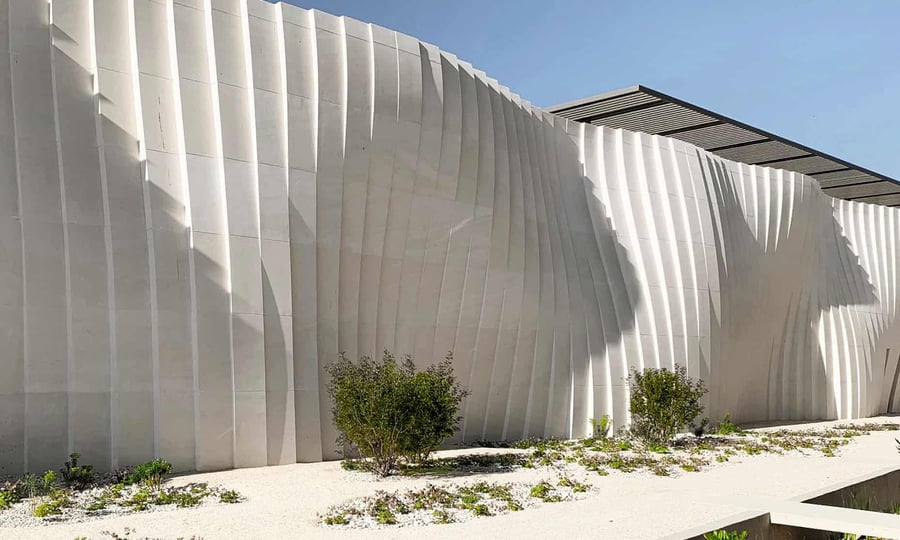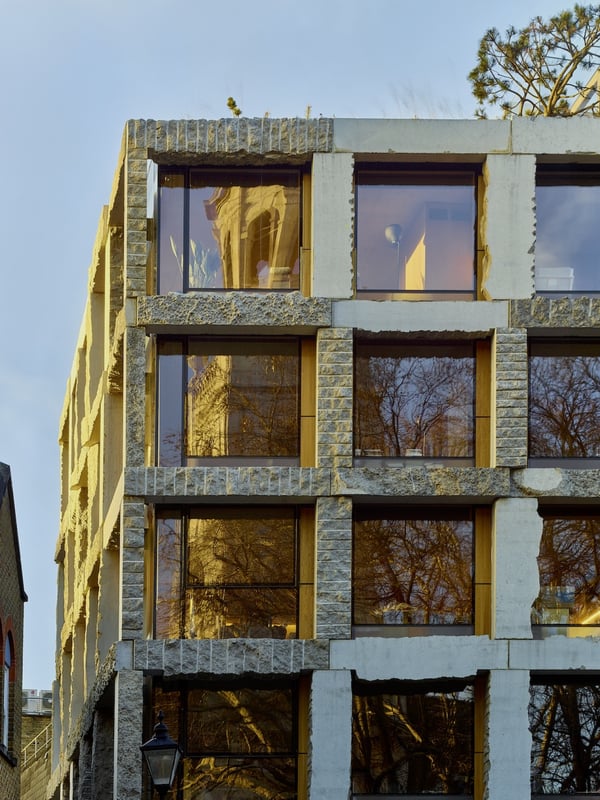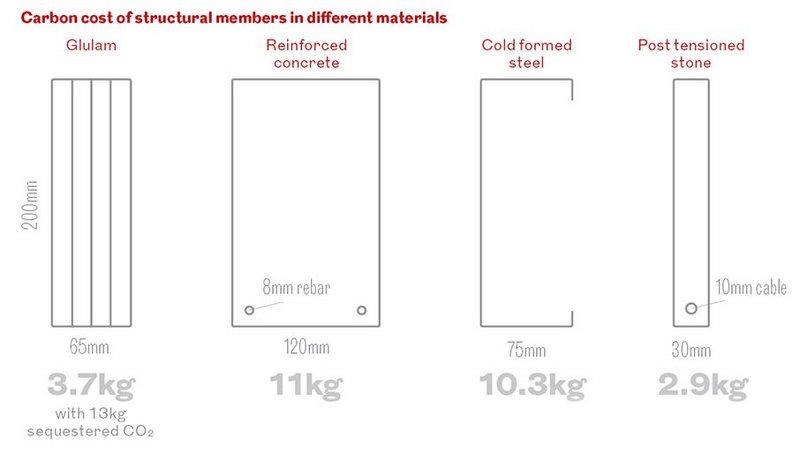
For millennia, natural stone has been used as the primary structural material for construction projects around the world, and the future looks remarkably like that past. The modern building industry is increasingly choosing natural stone materials for their projects due to their proven, trusted results and minimal environmental impact.
While steel and concrete require immense amounts of energy to produce, stone is ready to use: It’s Mother Nature’s original green building material and the time is ripe for a return to stone as a structural material.
Provocative architect Amin Taha of Groupwork, Steve Webb director of award-winning multidisciplinary engineering practice Webb Yates, and stonemason Pierre Bidaud from The Stonemasonry Company Ltd, are leading the charge on the structural stone renaissance. Together they curated The New Stone Age exhibition, a celebration of the potential and beauty of structural stone, as well as its inherent sustainability. The exhibition, at London’s Building Centre, showed the potential of stone as a modern construction material and surveyed the contemporary use of structural stone. BBC recently published an article on the resurgence of natural stone as a structural material.
 Structural stone used for Wine Museum in Corsica, France. Credit: Perraudin Architecture
Structural stone used for Wine Museum in Corsica, France. Credit: Perraudin Architecture
The exhibition was focused on demonstrating how stone, which has recently been relegated to usage as primarily an independently hung facade, can be used as a structural material in itself to create contemporary buildings and aimed to widen the discussion about stone as a structural alternative to concrete and steel. Yes, stone which has been used to create buildings for millennia, has the potential to revolutionize construction today.
 Self-supporting, structural stone spiral staircase. Credit: The Stonemasonry Company Ltd. and Pierre Bidaud
Self-supporting, structural stone spiral staircase. Credit: The Stonemasonry Company Ltd. and Pierre Bidaud
The trio of Taha, Webb and Bidaud had previously worked together to build 15 Clerkenwell Close, a six-story housing block in London that features a load-bearing exoskeleton made of massive chunks of raw limestone brought straight from the quarry. The stone bears the marks of drilling, splitting and sawing and features a range of textures and colors from that process. The mixed-use space was initially controversial but quickly raised the profile of stone as a structural element. It deftly sits in the balance between history (the first structure on the site was an Augustinian nunnery, built of limestone not long after the Norman invasion) and modernity (while it references the building methods of the Normans, it is clearly a contemporary creation) telling a unique story.
 15 Clerkenwell Close, Architect: Amin Taha, Groupwork Credit: Amin Taha
15 Clerkenwell Close, Architect: Amin Taha, Groupwork Credit: Amin Taha
"We've only just rediscovered what architects have known for 7,000 years," said Taha in an interview with Dezeen. "Stone is versatile, has strength, longevity, is plentiful, cheap and, with zero embodied carbon, well placed for a renaissance."
Using stone in construction is an ancient concept, but the value of its environmental impact has new importance. With its enduring life-cycle, durability, ease of care and maintenance, recyclability, and energy efficiency, stone can easily replace many concrete and steel applications. Since stone comes straight from the earth, it’s 100% recyclable, plus there are no extra manufacturing steps to be taken, which means less consumption of energy. As Steve Webb points out in a recent Riba Journal article on bringing stone back into the structural engineering conversation, “In production terms stone has an even lower carbon footprint than timber; over 70% less CO2/m2 than steel or concrete”.
 Source: The RIBA Journal, "Why The Time Is Ripe For A Return To Stone As A Structural Material", 29, May 2020
Source: The RIBA Journal, "Why The Time Is Ripe For A Return To Stone As A Structural Material", 29, May 2020
Architects are uniquely positioned to address concerns about energy consumption and CO2 emissions by implementing innovative sustainable design strategies, such as using natural stone in a structural capacity.
“You go to work on your bicycle, you recycle, you only buy organically grown locally farmed veggies, you're even a vegan - you're doing everything you can for the environment and you get to the office, sit down at your drawing desk and you design a building in steel and concrete?” said Valérie Bergeron, the director of business development in Europe for Polycor. “It just doesn't add up, it doesn't make sense. Using stone as a load-bearing construction material can reduce the carbon footprint for up to 90% of the structure. Stone is just naturally sustainable.” Although not at the forefront of builder's and architect's minds prior to the 20th century, natural stone was considered a resilient building stone in its own right, with a proven track record. Read more about New York city's skyline being grounded in Polycor building stone here.
.png?width=460&name=Screenshot%20(1299).png)
Sustainable design focuses on limiting a building’s impact on the environment and on getting more out of our natural resources, and stone is perfectly positioned to provide those benefits for generations to come. Modern methods of fabrication and design can unlock the nearly endless potential of one of our planet’s most abundant natural resources, stone.
Gilles Perraudin of Perraudin Architects is one of the pioneers in this resurgence of building with structural stone. His book Constructing in Massive Stone Today, continues to influence architects and engineers to this day, as do his innovative projects that he realizes building with solid blocks of natural stone. Perraudin's designs were a call to arms in the twentieth century for other like-minded visionaries when he personally took on the task of GC'ing his projects after facing push back from skeptical contractors and tradespeople.
.png?width=476&name=Screenshot%20(1315).png) Gilles Perraudin setting stone blocks for one of his early structural stone builds.
Gilles Perraudin setting stone blocks for one of his early structural stone builds.
Credit: Gilles Perraudin
For many clients, one of the main advantages of stone is its aesthetic, but its association with classical and excessive ornamentation can cause it to be overlooked on the basis that these are the only styles or motifs that can be achieved with structural stone. In fact, the opposite is true. There’s unlimited design potential when working with such a homogenous material throughout. The advent of CNC tooling and new advances in cutting, milling and quarrying technologies have unlocked new directions in stone design where parabolic shapes can follow creative architectural concepts. Stone’s compressive strength means that it can easily replace many concrete and steel applications in the process, plus its flexural strength is substantially higher than concrete requiring less internal reinforcement.
Research led by Taha, Bidaud and Webb found that large commercial buildings could be built more cheaply and with less of an environmental impact using stone rather than concrete or steel.
“Stone as combined superstructure and external architectural finish allows us an opportunity, by limiting the input of energy in processing, transportation and construction to drop the world’s CO2 emissions - of which the building industry contributes 33% - by anything between 60% and 90% for these key building elements,” said Taha. “This is far in excess of our current thought of as ambitious targets and yet simply achieved by once more including stone as part of the family of structural-architectural materials.”
Taha, Bidaud, Webb and Bergeron—alongside French practices Perraudin Architecture, and Carl Fredrik Svenstedt Architects spoke about their extensive experiences of working with stone in a roundtable webinar discussion, “Contemporary Stone Architecture: The Art And Science Of Building In Stone.” The webinar presented a unique opportunity to meet and learn from contemporary practices working with stone in the most innovative way, heralding in the new Renaissance of structural stone. Watch the full version on YouTube linked above.
Want to learn more about the sustainable credentials of building with stone? Visit our Naturally Sustainable page to see Polycor's Environmental Report, download HPD's and access other relevant data and information.
*Cover image - Credit: Carl Fredrick Stenstead Architects
